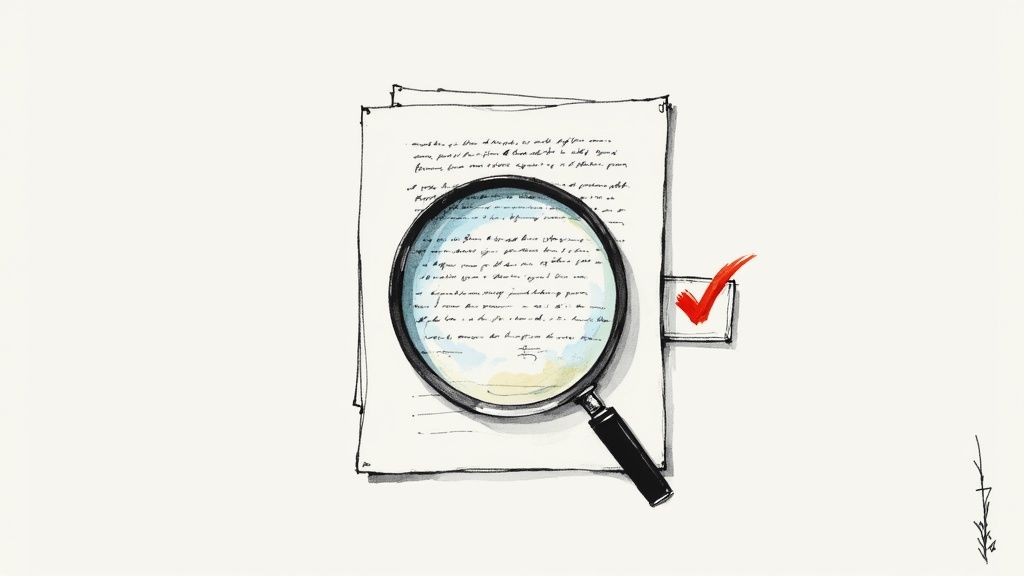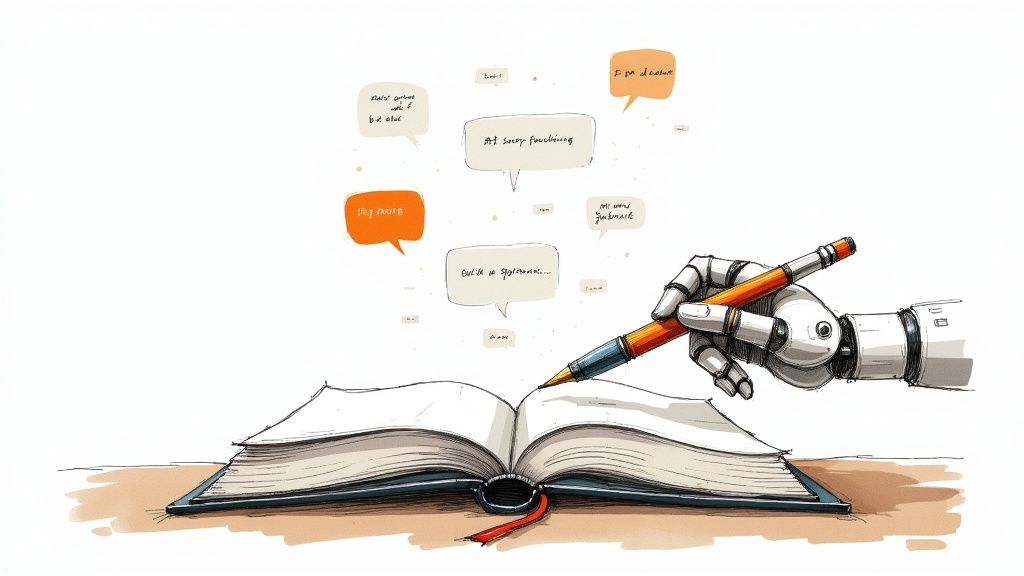How to Become a Published Author

You’ve done it. You’ve written a book. That’s a monumental accomplishment, and you should take a moment to celebrate it. But as you know, finishing the manuscript is just the first major hurdle. Now, you’re at a crossroads, facing a decision that will define your author career: do you go the traditional route or self-publish?
There’s no single "right" answer here. These two paths offer vastly different experiences, timelines, and financial realities. One isn't inherently better than the other, but one will absolutely be a better fit for your goals, your genre, and how much control you want over your creative work.
The Modern Publishing Landscape
This choice is more relevant today than ever before. The global digital publishing market was valued at around $45.4 billion in 2024 and is on a steady upward climb, fueled by the explosive popularity of ebooks and audiobooks. This digital boom has opened up incredible opportunities for authors, no matter which path they take. You can dig deeper into these global publishing industry trends to see what they mean for authors like you.
To get a quick sense of the core differences, just look at the average time to release and the typical royalty rates for each.

The data really lays out the fundamental trade-off. Traditional publishing offers the prestige of a publishing house and access to their distribution network, but you're looking at a much slower process and smaller royalty checks. On the other hand, self-publishing gives you speed and a much bigger slice of the pie, but you're the one in charge of everything.
Traditional vs. Self-Publishing At a Glance
Making this choice can feel overwhelming, so let's break down the key differences in a more direct way. This table gives you a side-by-side comparison to help you see where each path shines and what the trade-offs are.
| Aspect | Traditional Publishing | Self-Publishing |
|---|---|---|
| Creative Control | Limited. Publisher has final say on edits, cover, and title. | Absolute. You make every decision. |
| Upfront Costs | None. The publisher invests in you. | You fund everything: editing, design, marketing, etc. |
| Time to Market | Slow. Typically 18-24 months after signing the contract. | Fast. Can be as little as a few weeks or months. |
| Royalties | Lower. Averages 5-15% of net receipts. | Higher. Typically 40-70% of the book's price. |
| Distribution | Broad. Access to physical bookstores, libraries, and major retailers. | Primarily online, though print-on-demand is expanding. |
| Validation | High. The "stamp of approval" from an established publisher. | Comes directly from readers and sales figures. |
As you can see, the decision hinges on what you value most: the established support and validation of a traditional deal, or the speed, control, and higher earning potential of doing it yourself.
Key Factors in Your Decision
Beyond the numbers, your choice comes down to personal and professional priorities. It’s not just about money or speed.
Think about these key questions as you weigh your options:
- Creative Control: How important is it for you to have the final say on your book's cover, title, and edits? If you're a purist, self-publishing gives you complete autonomy.
- Upfront Investment: Traditional publishers foot the bill for production. If you self-publish, you’ll be funding everything from editing to marketing out of your own pocket.
- Industry Validation: For many writers, the validation of a traditional book deal is a lifelong dream. For others, building a direct line to their readers is far more rewarding.
- Marketing Responsibility: Don't be fooled—even with a traditional deal, authors are expected to do a lot of their own promotion. In self-publishing, however, 100% of the marketing falls on you.
This isn't just a business decision; it’s about aligning your publishing journey with your creative vision and entrepreneurial spirit. Think about what success truly looks like for you. Is it seeing your book on a shelf in a major bookstore, or is it building a sustainable business around your writing on your own terms? Answering that question is the first real step.
Crafting a Manuscript That Demands Attention

Before you even think about querying agents or uploading to a self-publishing platform, your manuscript has to be as close to perfect as you can get it. A great idea is just the starting point; it's the execution that makes agents, editors, and eventually readers, sit up and take notice. This is where you transform that rough diamond of a first draft into a polished, professional piece of work.
Professional writing software can streamline your manuscript development and organization. If you're still using basic word processors, explore our guide to Scrivener alternatives for tools that help you manage complex manuscripts professionally—many offer free options to get started.
Too many aspiring authors fall into the trap of thinking an agent or editor will fix a messy manuscript. Let me be blunt: that’s not their job. A draft riddled with plot holes, clunky prose, or glaring typos is almost guaranteed to land in the slush pile. A rigorous editing process is non-negotiable, whether you’re aiming for a Big Five publisher or planning to self-publish.
Getting Serious About Editing
Editing isn't just one step; it’s a series of distinct, crucial layers. If you skip one, the whole structure can feel wobbly. Think of it like building a house: you need a solid foundation (the story), sturdy walls (the prose), and a flawless coat of paint (the final polish).
Let's break down what that really looks like.
The Major Editing Stages
Developmental Editing: This is your big-picture overhaul. A good developmental editor digs into the guts of your story—the plot, character arcs, pacing, and overall structure. They'll challenge you with the tough questions. Does your hero’s motivation actually hold up? Is the ending truly satisfying? This is where you fix foundational problems before you waste time polishing sentences that might get cut anyway.
Copyediting (or Line Editing): Once the story itself is solid, the focus zooms in. A copyeditor works at the paragraph and sentence level to make your prose sing. They tighten wordy sentences, smooth out awkward phrasing, and ensure your authorial voice comes through clearly and consistently. This is all about clarity, flow, and style.
Proofreading: This is the last line of defense. A proofreader is your final, meticulous inspector, hunting down every last typo, grammatical slip, punctuation error, and formatting glitch. They catch the little mistakes that can jolt a reader right out of the world you’ve created.
"Revision never stops. You're not done with your book even after it gets published...when I'm doing book events and I'm reading from my new published book, I'm not always reading the words on the page. I am sort of editing them as I go."
— Mary Adkins, Author
Mary's point really hits home. If even a published author is still tweaking their work, it shows just how critical it is to get your manuscript as clean as possible from the start. You want to minimize those "I wish I'd fixed that" moments later on.
Finding and Vetting a Freelance Editor
Unless you land a traditional deal where the publisher provides an in-house team, you’re going to need to hire a freelance editor. Don't skimp here. This is one of the most important investments you can make in your writing career.
But how do you find the right person? Start by looking for editors who specialize in your genre. You wouldn't hire a romance editor for your hard sci-fi epic, right? Professional databases like the Editorial Freelancers Association (EFA) are a fantastic place to find qualified, experienced pros.
When you have a shortlist, vet them carefully. Always ask for a sample edit. Most will edit 5-10 pages of your manuscript (sometimes for free, sometimes for a small fee). This is your chance to see their editing style up close and decide if their feedback aligns with your vision for the book.
As you polish your manuscript, it's also smart to get familiar with how to protect your work. Understanding the key differences between trademark and copyright is a foundational step in securing your intellectual property.
Ultimately, a professionally polished manuscript is your most powerful asset. It tells the industry you're serious, it respects the reader’s time, and it’s the clearest sign that you are a dedicated professional in your craft.
Navigating the Traditional Publishing Route

So, you dream of seeing your book on the shelves at Barnes & Noble? That’s the traditional publishing path. It’s a long game, one that demands patience, a solid strategy, and frankly, a pretty thick skin. This is the route where you partner with industry pros who invest their own money in your book, but first, you have to convince them you're worth the bet.
Your first and most crucial mission is to land a literary agent. Think of them as your advocate, your champion, and the gatekeeper to the big publishing houses. With very few exceptions, major publishers don't even look at manuscripts sent directly from authors. An agent’s job is to pluck your manuscript from the slush pile and get it into the right editor's hands.
Finding and Querying a Literary Agent
First things first: you need to find agents who actually represent your kind of book. Don't waste your time or theirs. If you've written a gritty crime thriller, there's no point in querying an agent who only handles young adult fantasy.
Build your target list using online databases and industry resources. As you do, pay very close attention to each agent's specific submission guidelines. Some want the first ten pages, others ask for a full synopsis, and nearly all have precise formatting rules. Following their instructions to the letter is your first test—it shows you’re a professional who can follow directions.
When you’re finally ready to hit "send," you'll need three key documents polished to a high shine:
- The Query Letter: This is your one-page sales pitch. It needs a killer hook, a short-and-sweet summary of your book, a brief author bio, and a line or two showing why you chose that specific agent.
- The Synopsis: A one-to-two-page summary of your entire story, from beginning to end. Yes, you have to spoil the ending. An agent needs to see that you’ve built a coherent plot that actually works.
- Sample Pages: Usually the first few chapters of your manuscript. This is where your writing has to grab them by the throat and not let go. It has to be your absolute best work.
Don’t worry about payment—a legitimate agent won’t charge you a dime upfront. They work on commission, taking 15% of what you earn from the book deal. Before you balk at that number, remember this: if they can't sell your book, they don't get paid. It's a true partnership built on the belief that your work will succeed.
What Happens After You Sign with an Agent
Getting that "yes" from an agent is a huge milestone, but it's just the beginning of a new chapter. Your agent will almost certainly have you do another round of revisions. They know the market inside and out and will help you shape the manuscript to catch an editor's eye.
Once the manuscript is ready for primetime, your agent will build a submission list of editors and start pitching your book. This is when you go "on submission," and it can be an incredibly nerve-wracking time. It might take weeks, months, or even longer to hear anything back. You'll need resilience to get through the silence and the inevitable rejections.
If an editor loves it, they’ll make an offer. This is where your agent truly shines. They’ll negotiate the entire contract for you, fighting for the best possible advance, royalty rates, and subsidiary rights (like film, audio, or foreign translation rights).
Understanding the Financials of a Book Deal
Let's talk money. A traditional book deal almost always includes an advance against royalties. The advance is a sum of money the publisher pays you before the book is even published. But it isn't free cash—it's an advance on your future earnings.
You won't see another paycheck from the publisher until your book has sold enough copies to "earn out" that advance. For example, if you get a $10,000 advance and your royalty is $1 per book, you’ll need to sell 10,000 copies before you start earning royalties.
That advance is usually paid in chunks, something like this:
- One-third when you sign the publishing contract.
- One-third when you deliver the final, fully-edited manuscript.
- One-third when the book is officially published.
Despite the hurdles, traditional publishing is far from dead. The global book market is projected to reach about $142.7 billion in 2025, and it continues to grow. Online book sales, in particular, show how healthy and adaptable the industry is. You can dig into more book sales statistics at Newprint.com to see the trends for yourself. This expanding market means publishers are always hungry for the next great story. Yours could be it.
Diving Into the World of Self-Publishing

If the traditional route feels like waiting for someone else to say "yes," self-publishing is you grabbing the microphone and saying it yourself. This path puts you squarely in the driver's seat, shifting your role from just "author" to "author-entrepreneur." It's an incredibly powerful and legitimate way to build a writing career entirely on your own terms.
When you self-publish, you're the CEO of your book. Every single decision—from the cover art and interior layout to the launch price and marketing plan—is yours to make. That level of control is liberating, but it also means the buck stops with you.
You Don't Have to Go It Alone: Build Your A-Team
"Self-publishing" is a bit of a misnomer. The most successful authors don't do everything themselves; they act as project managers and hire a team of pros. This is where you absolutely cannot afford to cut corners if you want your book to stand shoulder-to-shoulder with traditionally published titles.
At a minimum, your dream team should include:
- A Professional Editor: We talked about this earlier, but it’s critical. You need an editor who lives and breathes your genre to handle the developmental edit, copyedit, and final proofread.
- A Killer Cover Designer: We all judge books by their covers. It’s human nature. A pro designer who knows the visual language of your genre is one of the best investments you'll ever make.
- An Interior Formatter: This is the unsung hero who makes sure your ebook looks sharp on any device and your print book’s pages are clean and easy to read. It's a technical skill that massively impacts the reader's experience.
Self-publishing isn’t about doing every single task yourself. It's about owning every single decision. Your job is to hire the best talent you can find to create a book that readers will genuinely love. Getting that mindset right is half the battle.
The growth in self-publishing has been nothing short of astounding. Over the last five years, its output has skyrocketed by a massive 264%. Just last year, in 2023, the U.S. market saw around 500,000 new self-published books hit the shelves, completely eclipsing the 10,000 or so from traditional houses.
Of course, that means more competition, but it also points to a thriving market driven by authors. To jump in, expect to invest anywhere from $2,940 to $5,660 in 2025 for quality editing, design, and setup. Think of it as startup capital for your author business. The Alliance of Independent Authors has some great data on this trend.
Where Will You Sell Your Book?
With your polished book files in hand, the next big question is distribution. You have two main strategies here: go "exclusive" with one major retailer or go "wide" and make your book available everywhere.
Amazon’s Kindle Direct Publishing (KDP) is the undisputed giant. Their KDP Select program offers perks—like inclusion in Kindle Unlimited (where you get paid for pages read) and access to special promotional tools—but it requires a 90-day exclusivity commitment for your ebook.
The alternative is to go wide. This means you still publish on KDP (just not in KDP Select) and use an aggregator service like Draft2Digital or IngramSpark to push your book out to other storefronts like Apple Books, Barnes & Noble, and Kobo. Going wide builds a more resilient and diversified income stream over the long run.
The Financial Side of Things
As an indie author, you're in charge of pricing, and you keep a much bigger slice of the pie. Royalties are way higher than in traditional publishing, typically between 35% and 70% of your book’s list price.
The catch? You foot all the upfront bills.
| Expense Category | Typical Cost Range | Why It's Worth It |
|---|---|---|
| Editing | $1,000 - $3,000+ | Guarantees a polished, professional read that earns great reviews. |
| Cover Design | $400 - $1,500+ | This is your #1 marketing tool. It has to be amazing. |
| Formatting | $150 - $500 | Ensures a seamless reading experience in both digital and print. |
| Marketing | $500 - $5,000+ | This is how you find your readers; includes ads, promos, and tools. |
Don't think of these as expenses—they're investments. Every dollar you put into professional production and smart marketing gives your book a better shot at finding its audience and earning a profit. For a deeper dive into budgeting and strategy, our complete https://manuscriptreport.com/blog/self-publishing-guide has you covered. Launching a book this way is about launching a business.
Building Your Author Platform from Scratch
Let's talk about something that can feel daunting but is absolutely crucial, no matter which publishing path you choose: your author platform. Whether you're chasing a traditional deal or going the indie route, building a platform is non-negotiable.
Think of it this way: publishers are running a business. They are far more likely to bet on a writer who already has a built-in audience because it takes a huge amount of risk off their plate. If you're self-publishing, your platform is your business. It's how you'll find your readers and sell your books.
Don't panic—this isn't about becoming a huge influencer overnight. It’s about creating a small, genuine community around your writing. Your goal is to give people value and build a relationship before you ever ask them to buy a thing. You're gathering your future launch team.
Your Digital Headquarters: An Author Website
Every author needs a home base online, and that's your website. It's the one corner of the internet you truly own, a space immune to the whims of social media algorithms. This is where agents, editors, and, most importantly, readers will land when they Google your name.
Keep it simple. You don't need a flashy, complicated site. Just focus on the essentials:
- A Solid "About Me" Page: Who are you? What do you write? Why? Let your personality come through.
- A Home for Your Book: Even if it's not finished, create a page for your book. Post a compelling description, and when the time comes, this is where your buy links will go.
- An Email Signup Form: Make this impossible to miss. It's probably the most valuable piece of real estate on your entire site.
- A Way to Get in Touch: A simple contact form for professional inquiries is a must.
Your website is your central hub, but a hub is useless if no one visits. You'll need to learn some basic strategies to get more website traffic to ensure your digital home isn't just an empty room.
The Real Power Is in Your Email Newsletter
If your website is your home, your email list is your inner circle. Social media is fantastic for getting discovered, but your email list is where you build deep, lasting connections with the people who care most about your work.
An email lands directly in someone's personal inbox. It cuts through the noise in a way a social media post never can.
Start building that list from day one. You need to give people a good reason to hand over their email address. Offer a "reader magnet"—a free short story, a deleted scene, a checklist for writers in your genre, or just exclusive updates from your writing desk.
When it's time to launch your book, this is the group that will show up. They'll buy it, and they'll be the ones leaving those all-important early reviews. Trust me, a small, highly-engaged list of 500 subscribers is infinitely more valuable than 10,000 passive followers on social media.
Building an author platform is a marathon, not a sprint. It’s a long-term investment in your career. This isn't just a marketing task you check off a list; it's an ongoing conversation with your future readers. Start small, be consistent, and focus on genuine connection.
Choosing Your Social Media Battlefield
Please, do not try to be everywhere at once. It's a surefire path to burnout. The trick is to pick one or two platforms where your ideal readers actually hang out and, just as importantly, where you actually enjoy spending your time.
- Writing fantasy or YA? Visually-driven platforms like Instagram and TikTok are perfect. Think cover art, character aesthetics, and connecting with a passionate fan community.
- Writing thrillers or non-fiction? You might find a better home on X (formerly Twitter) or even LinkedIn, where you can jump into industry discussions and share your expertise.
- For almost any genre: A private Facebook group can be an incredibly powerful tool for fostering a tight-knit community where readers can geek out over your books together.
Authenticity is everything here. Nobody wants to follow a walking advertisement. Share your struggles, talk about other books you love, and actually engage with people. You're building relationships, not just a broadcast channel.
For a deeper dive, our comprehensive book marketing strategies guide lays out a more detailed roadmap. Remember, the connections you make today are the book sales you'll celebrate tomorrow.
What to Do After Your Book Is Published
That moment your book finally goes live is incredible. It’s the culmination of so much work, and you absolutely should celebrate it. But as any veteran author will tell you, publication day isn’t the finish line.
It’s actually the starting pistol for the next race. What you do in the weeks and months that follow will define your book's trajectory and set the stage for your entire career.
That initial launch week buzz is a powerful thing, but it fades fast. The real challenge—and where successful authors shine—is in creating sustained momentum. This is the point where you truly shift from "writer" to "published author," actively managing your book as the business asset it is.
Lean Into Your Early Readers
Your first readers are your new best friends. These are the people who pre-ordered, snagged a copy on day one, and are genuinely excited to talk about what you've created. Making them feel seen and appreciated should be your number one priority right now.
Jump into the comments on social media. Thank people who share photos of your book. If you have a newsletter, send out a personal, heartfelt thank-you. This isn't just about being polite; it’s about forging a real connection with a readership that will stick with you for the long haul.
A published book is a starting point for a conversation. Your job is no longer just to write the story, but to participate in the discussion it creates. Engaging with readers transforms them from passive consumers into active advocates for your work.
This is also the prime time to gently encourage reviews. Positive ratings on places like Amazon and Goodreads are pure gold—they provide the social proof that convinces hesitant buyers to take a chance on you. Don't be shy about asking your email list or social followers to leave a review if they enjoyed the story. You’ll be surprised how many are happy to help.
Keep the Marketing Engine Humming
Launch marketing is a sprint. Post-launch marketing is a marathon. You can't just stop everything once the book is out in the world. Now’s the time to pivot from high-intensity launch tactics to a steady, long-term strategy.
Think about weaving these activities into your routine:
- Consistent Content: Keep your blog or social media channels active. Talk about themes from your book, share behind-the-scenes tidbits, or discuss other books in your genre. This keeps you on people's radar and draws in new potential readers.
- Smart Advertising: If you have the budget, even a small, targeted ad campaign on Amazon or Facebook can create a steady drip of sales long after the launch hype has died down.
- Strategic Promotions: A few months down the line, plan a price drop or a Kindle Countdown Deal. This can generate a whole new wave of sales from readers who were waiting for the right moment to buy.
Many of the long-term strategies are universal, whether you're indie or traditionally published. Our guide on book marketing for self-published authors is packed with ideas that can help keep your book visible.
Start Scheming Your Next Book
Want to know the single best marketing tool for your first book?
It’s your next book.
Seriously. As soon as you have the bandwidth, start thinking about what’s next. It could be a sequel, a standalone in the same genre, or something totally different. Having another project in the works gives your new fans something to look forward to and proves to agents and publishers that you’re in this for the long run.
This is also a great time to think about expanding your book's reach into new formats. An audiobook can open up a whole new audience, and you can even explore different text-to-speech options for your Kindle book to increase accessibility.
By keeping the conversation going with readers, maintaining a steady marketing rhythm, and planning your next project, you turn that initial launch success into a real, sustainable career.
Ready to take the guesswork out of marketing your book? ManuscriptReport.com delivers a full-stack marketing report in minutes, packed with everything from blurbs and keywords to ad copy and social media posts. Spend less time on promotion and more time on your next bestseller at https://manuscriptreport.com.
Related Articles

Mastering Amazon KDP Keywords for More Sales
Unlock your book's potential with our guide to Amazon KDP keywords. Learn proven strategies to find high-impact keywords that attract readers and boost sales.

Auto Generate Book Blurb AI Guide
Learn to use an auto generate book blurb AI to write compelling descriptions that sell. This guide offers actionable tips for authors and self-publishers.

Mastering Character Archetypes for Writers
A complete guide to character archetypes. Learn how to use these timeless blueprints to build unforgettable characters and elevate your storytelling.